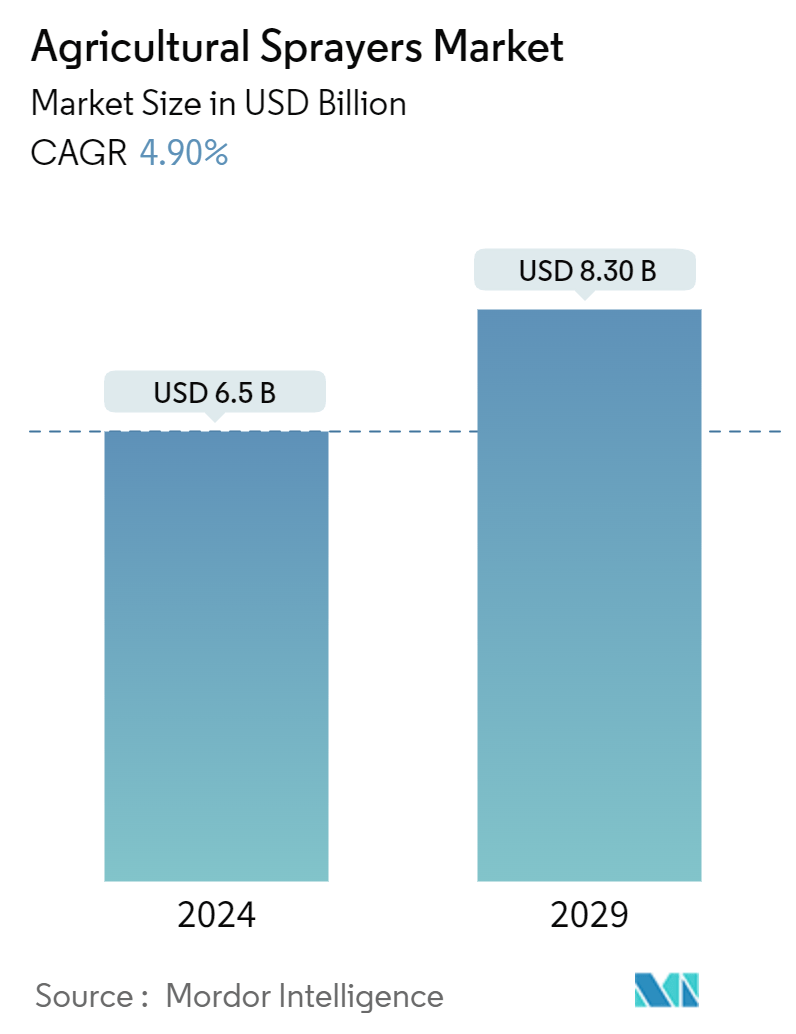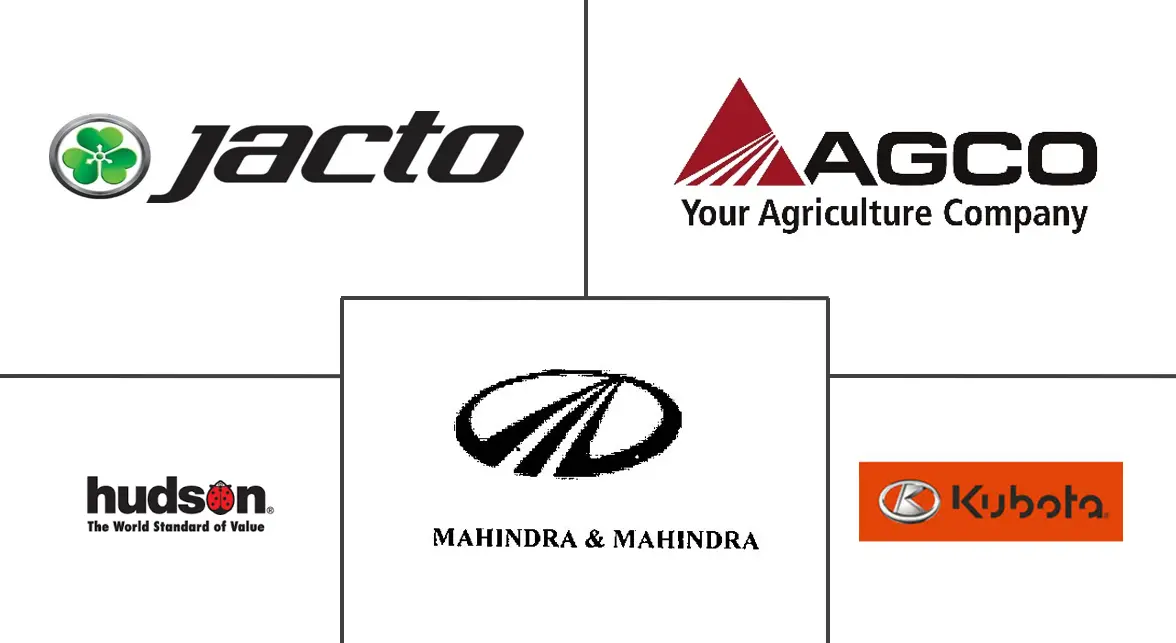
| Study Period | 2019 - 2029 |
| Market Size (2024) | USD 6.5 Billion |
| Market Size (2029) | USD 8.30 Billion |
| CAGR (2024 - 2029) | 4.90 % |
| Fastest Growing Market | North America |
| Largest Market | Europe |
| Market Concentration | High |
Major Players
*Disclaimer: Major Players sorted in no particular order |
Agricultural Sprayers Market Analysis
The Agricultural Sprayers Market size is estimated at USD 6.5 billion in 2024, and is expected to reach USD 8.30 billion by 2029, growing at a CAGR of 4.90% during the forecast period (2024-2029).
- Farming equipment is essential for increasing crop productivity and minimizing labor costs. Agricultural sprayers have become essential for growers to spray fertilizers, herbicides, and pesticides as required during harvest. Farmers could apply chemicals more effectively owing to technological advancements. Therefore, with changes in farming techniques and technological acceptance, the market for agricultural sprayers has gained traction.
- GPS and robotic system sprayers are popular in large agricultural land holdings, gardens, and orchard crops. Advanced spraying machinery uses this technology, wherein automated machines can apply pesticides and nutrients in a more targeted and timely manner. This technological development has resulted in farming activities becoming efficient and eco-friendly. However, most farmworkers are unaware of the dosage limits and pesticide risks and require proper training in integrated pest management practices. Hence, recent advancements in sprayer technology have reinforced the demand for agricultural sprayers and will have a long-term impact on the market.
- With the launch of AI-based agriculture machinery, products have led to a massive increase in farm mechanization, favoring the market's growth. For instance, in 2023, Ecorobotix, a Swiss AgriTech company, launched a precision sprayer, ARA, in Canada. This product is developed using AI technology and its unique ultra-high precision spraying system. It can recognize individual plants, classify them in real time, and spray on weeds without affecting surrounding crops or soil.
Agricultural Sprayers Industry Segmentation
Agricultural sprayers are types of equipment that are used to apply herbicides, pesticides, and fertilizers on crops. The agricultural sprayers market is segmented by source of power (manual, battery operated, solar sprayers, and fuel operated), usage (field sprayers, orchard sprayers, and gardening sprayers), and geography (North America, Europe, Asia-Pacific, South America, and Middle East and Africa). The report offers market estimation and forecasts in value (USD) for the above-mentioned segments.
| Manual |
| Battery Operated |
| Solar Sprayers |
| Fuel Operated |
| Field Sprayers |
| Orchard Sprayers |
| Gardening Sprayers |
| North America | United States |
| Canada | |
| Mexico | |
| Rest of North America | |
| Europe | Germany |
| United Kingdom | |
| France | |
| Italy | |
| Spain | |
| Rest of Europe | |
| Asia-Pacific | China |
| Japan | |
| India | |
| Australia | |
| Rest of Asia-Pacific | |
| South America | Brazil |
| Argentina | |
| Rest of South America | |
| Middle East and Africa | South Africa |
| Rest of Middle East and Africa |
Agricultural Sprayers Market Size Summary
The agricultural sprayers market is experiencing significant growth, driven by the increasing need for efficient farming equipment to boost crop productivity and reduce labor costs. Technological advancements have made it possible for farmers to apply fertilizers, herbicides, and pesticides more effectively, leading to a surge in the adoption of agricultural sprayers. The market is further propelled by the emphasis on farm efficiency, rising cereal and grain production, and supportive government policies promoting innovative agricultural practices. The introduction of advanced technologies such as GPS and robotic systems in sprayers has enhanced the precision and timeliness of pesticide and nutrient application, making farming activities more efficient and environmentally friendly. Despite the need for proper training in integrated pest management practices, these technological developments have reinforced the demand for agricultural sprayers, promising a long-term positive impact on the market.
Globally, the agricultural sprayers market is witnessing a shift towards advanced technologies like drones and driverless sprayers, offering lucrative growth opportunities. These innovations enable farmers to scout for pests, identify mid-field weeds, and map yields even under challenging weather conditions. The European market, in particular, is leading the charge with expanding farm sizes and a growing demand for high-capacity sprayers. Initiatives like the INNOSETA project aim to bridge the gap between research and practical application, further boosting market growth. Companies are heavily investing in research and development to introduce advanced sprayer technologies, such as solar-powered and self-propelled sprayers, to meet the rising demand. The market is moderately consolidated, with major players engaging in partnerships and acquisitions to strengthen their market presence.
Agricultural Sprayers Market Size - Table of Contents
1. MARKET DYNAMICS
- 1.1 Market Overview
-
1.2 Market Drivers
- 1.2.1 Technological Developments in Spraying Equipment
- 1.2.2 Changing Farming Trends
- 1.2.3 Subsidy Programs by Governments
-
1.3 Market Restraints
- 1.3.1 Lack of Technical Knowledge and Skill
- 1.3.2 Impacts of Beliefs and Traditional Practices
-
1.4 Porter's Five Forces Analysis
- 1.4.1 Bargaining Power of Suppliers
- 1.4.2 Bargaining Power of Buyers/Consumers
- 1.4.3 Threat of New Entrants
- 1.4.4 Threat of Substitute Products
- 1.4.5 Intensity of Competitive Rivalry
2. MARKET SEGMENTATION
-
2.1 Source of Power
- 2.1.1 Manual
- 2.1.2 Battery Operated
- 2.1.3 Solar Sprayers
- 2.1.4 Fuel Operated
-
2.2 Usage
- 2.2.1 Field Sprayers
- 2.2.2 Orchard Sprayers
- 2.2.3 Gardening Sprayers
-
2.3 Geography
- 2.3.1 North America
- 2.3.1.1 United States
- 2.3.1.2 Canada
- 2.3.1.3 Mexico
- 2.3.1.4 Rest of North America
- 2.3.2 Europe
- 2.3.2.1 Germany
- 2.3.2.2 United Kingdom
- 2.3.2.3 France
- 2.3.2.4 Italy
- 2.3.2.5 Spain
- 2.3.2.6 Rest of Europe
- 2.3.3 Asia-Pacific
- 2.3.3.1 China
- 2.3.3.2 Japan
- 2.3.3.3 India
- 2.3.3.4 Australia
- 2.3.3.5 Rest of Asia-Pacific
- 2.3.4 South America
- 2.3.4.1 Brazil
- 2.3.4.2 Argentina
- 2.3.4.3 Rest of South America
- 2.3.5 Middle East and Africa
- 2.3.5.1 South Africa
- 2.3.5.2 Rest of Middle East and Africa
Agricultural Sprayers Market Research FAQs
How big is the Agricultural Sprayers Market?
The Agricultural Sprayers Market size is expected to reach USD 6.82 billion in 2025 and grow at a CAGR of 4.90% to reach USD 8.66 billion by 2030.
What is the current Agricultural Sprayers Market size?
In 2025, the Agricultural Sprayers Market size is expected to reach USD 6.82 billion.


